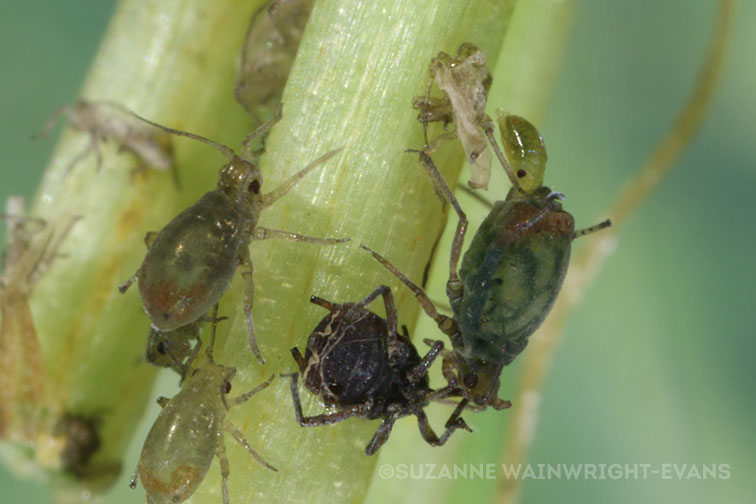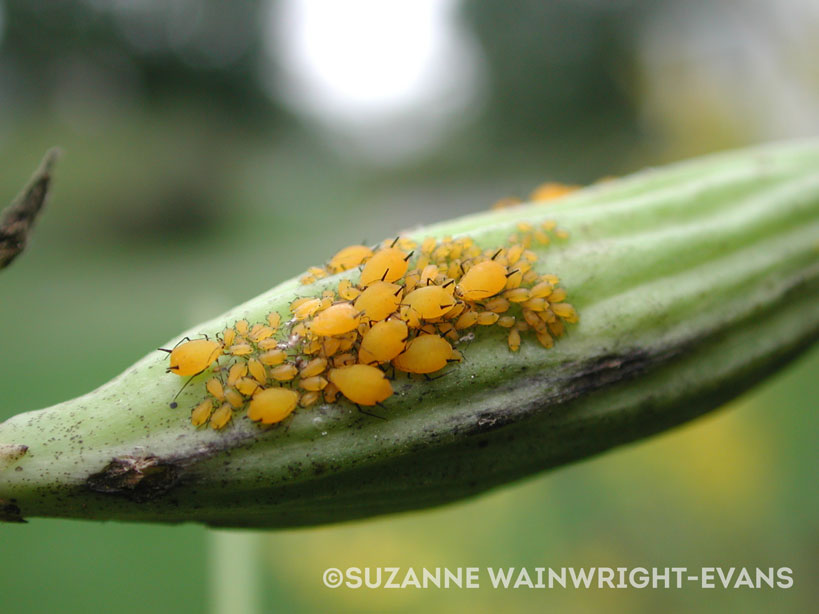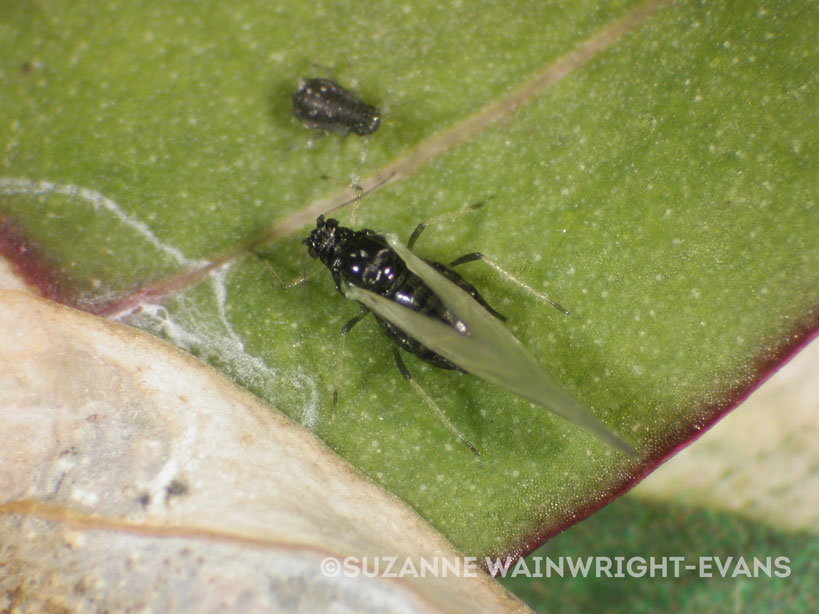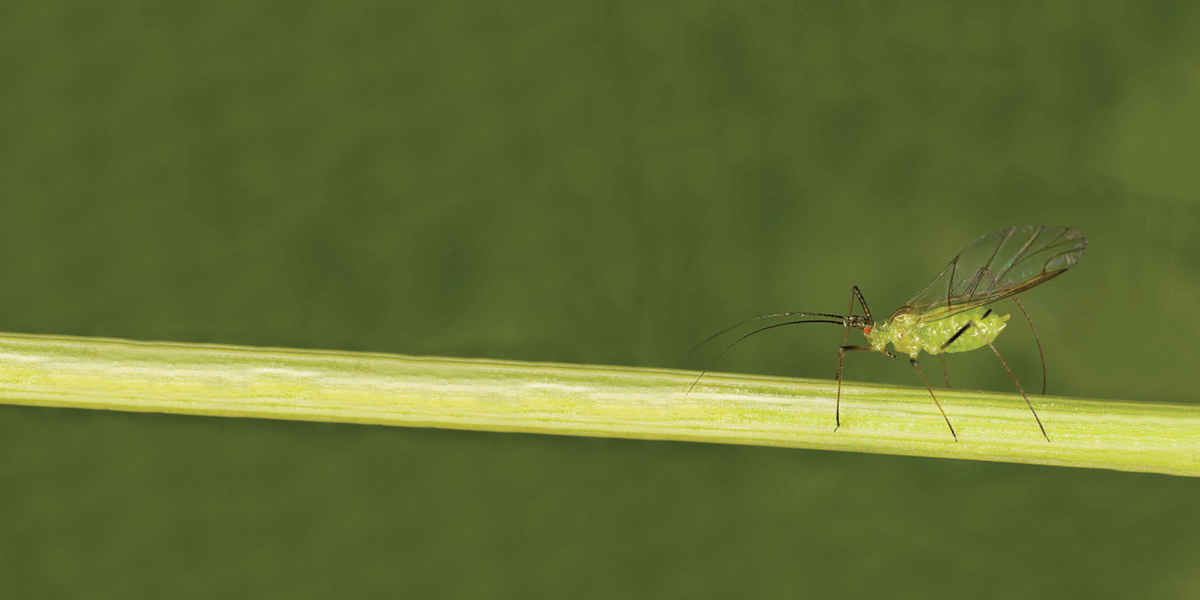Unusual Aphids
Look closer to see what’s really weird about one of the most troublesome insect pests out there.
Aphids are like cows in the sense that to avoid being eaten, they just have to outrun their friends.
It’s not that they don’t have any defenses, says Suzanne Wainwright-Evans, owner of Buglady Consulting, but they are “basically a bag of water with a mouth and a butt.” Their defense is sheer numbers.
Several functions allow aphids to reproduce effectively and create large populations, Wainwright-Evans says. For instance, she says, they don’t have to mate to reproduce. Called parthenogenesis, this is a form of asexual reproduction.
Another thing: while many insects must lay eggs to produce offspring, that’s not the case with aphids, Wainwright-Evans says.
“They just pew, pew, pew out the back door,” she says.
Having live births allows aphids to skip waiting for their eggs to hatch. “They are having just live little aphids being born every day,” Wainwright-Evans says.
Interestingly, humans can essentially perform an ultrasound on an aphid using a microscope.
“You can actually see with aphids sometimes, especially aphid species that have red eyes, the baby aphids inside of momma aphid in there if you look through her,” Wainwright-Evans says.
But wait ...
Aphids are funky in part because they are able to change their physical appearance and functions. Just because they don’t usually lay eggs, for example, doesn’t mean they never do.
“Typically, outdoors in the north, they will lay eggs to overwinter outdoors because it’s a very harsh environment and eggs are suited to be able to handle the winter,” Wainwright-Evans says.
Meanwhile, in warmer climates and greenhouses, aphids don’t often receive environmental cues to lay eggs.
“You have to know your environment to know what kind of life cycle your aphid’s going to have because you talk about them overwintering as eggs — that’s only in the north outside,” Wainwright-Evans says. “It doesn’t apply to the people in South Florida. They need to be vigilant about aphids year-round.”
They believe they can fly (and do)
Aphids don’t have wings, Wainwright-Evans says — unless they need them.
About 90% of the time, she says, aphids don’t fly. But they will produce winged (alate) offspring if their populations get too crowded or they need to fly away to lay eggs.
“Basically, they have the ability to flip a switch and be like, ‘Okay, environmental cues, it’s telling me it’s time to have babies with wings.’ Then boop, all of a sudden, she can start having babies that are going to develop wings,” Wainwright-Evans says.
When it comes to identifying aphids with wings, she warns that they don’t look the same as wingless (apterous) aphids with wings added on. The rest of their bodies also look different.
In common greenhouse species, it’s unique that an insect can, on cue, produce offspring that can fly, Wainwright-Evans says.
“Thrips don’t have that option; whiteflies don’t have that option,” she says. “It’s pretty special to aphids.”
Ant Aid
Sometimes people think that aphids chew holes in plants. Wainwright-Evans compares their mouthparts more to straws. They suck plant juices out of leaves, stems and roots, damaging the plants.
Aphids then excrete honeydew, which is high in sugar and attracts sugar-hungry ants.
“It’s basically like a soda fountain for them,” Wainwright-Evans says. “And in return, the ants actually will protect the aphids from predators. They actually pick them up and move them to new plants to help with their distribution. It’s just like they’re farmers farming dairy cattle. Instead of milk, they’re getting sugar water, and the farmers protect the cows from wolves, and the wolves would be the beneficials.”
Putting wolves at the door
Wolves make a good analogy for beneficial insects because beneficials brazenly decimate nearly defenseless aphids. Growers should use them alongside spray products, Wainwright-Evans says.
Using beneficials in aphid management is important, she says, because there is not much genetic diversity in aphid populations. If the mother becomes resistant to a heavily used spray product, there is a good chance the offspring will be resistant, too.
There are spray products on the market that are compatible with beneficials. Just check with your biocontrol supplier for help. These spray products can last longer if growers use them with beneficials, Wainwright-Evans says.
“For the most part, this is why biocontrol has been of such interest to aphid management — and especially if you fold the bios in with compatible pesticides, you’re able to make the pesticides work longer because you’re not relying on them so heavily,” she says.






